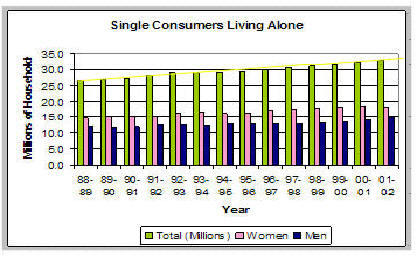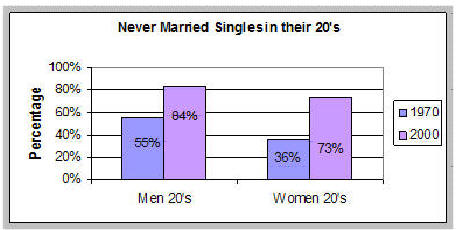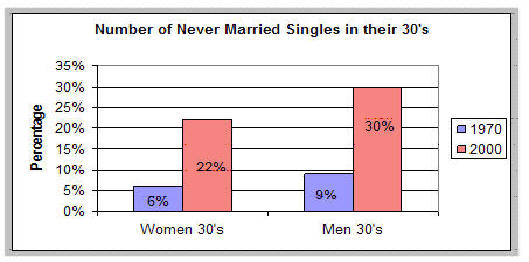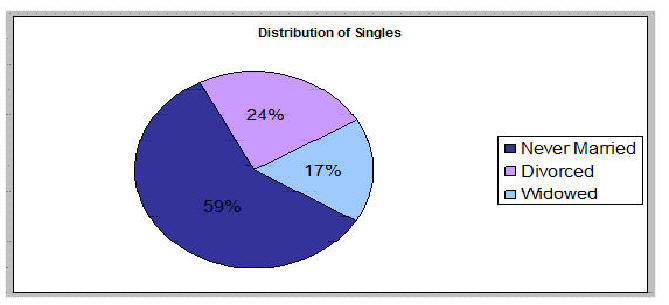April 2005

The
$ingle
Dollar: $1.6 Trillion Strong!
Marketing To Unmarried Consumers --
What You Need to Know
Growth in non-traditional-family households will continue to drive
purchasing decisions – this is not a passing phase; it is a trend that
will continue for the next several years. The impact on population growth
and society will have dire consequences for brands that do not make
provisions for marketing uniquely to singles. While this will present a
challenge for some, it also presents new opportunities for marketers to
effectively target, reach and maintain the loyalty of this vast and ever
expanding universe – singledom.
Singles at a Glance – Single But Not Alone
- $1.6 TRILLION in annual spending
- 86 Million+ Americans Are Single
- 32.9 Million Singles Live Alone
- 49.8 % of the Nation’s Consumer Units or
- 55.8 Million US Households are occupied by Unmarried Americans
- 42% Of The Nation’s Workforce Is Single
- 35% Of All Voters in the 2000 Election were single
introduction:
During the 2004 election, the need to uniquely target singles has
been concretely reasserted by the lack of options through which both
presidential candidates could woo the burgeoning numbers of unmarried
voters while maintaining the loyalty of their married constituents.
Politicians aren’t the only ones facing this dilemma; marketers are also
figuring out efficient means to uniquely address today’s highly segmented
American demographic.
Today, the single lifestyle remains the permanent backdrop of the entertainment scene. TV shows have some of their biggest performance with shows featuring the single life; Nearly 40 Million viewers watched Joe Millionaire and 26 million viewers tuned in to see ABC’s bachelor pick a date. Three of the most successful shows on Television; Seinfeld, Sex in the City and Friends all had single-about-town themes – a far cry from family-centric shows of the past.
This cultural shift is reflective of the fact that singles are shaping new and emerging markets; requiring that businesses rethink their processes and approach. The social influence, distinctive characteristics and gigantic wallet full of discretionary income, make it necessary that marketers gain an intimate understanding of their specific behaviors, needs and motivations. While some aspects are easy to codify, there are many intangibles that are difficult to grasp and even more difficult to quantify.
This report combines a series of surveys, logical projections, intuitive observations, and comparative analysis to translate and communicate the underlying beliefs, attributes and core values of unmarried Americans that marketers need to deepen their connection to this key demographic of sole decision makers and influencers thereby stretch their marketing dollar to its outer limits.
who are they -- a
marketer’s sweet spot !
There are over 86 Million single Americans in the USA today. The
United States has more single adults than any other nation in the world
except for China and India There are more single head of households than
there are married households with children. American has gone from being
“Married with Children” to being “Home Alone.” Since 1990 the percentage
of households and the number of states with majority households headed by
singles has continued to escalate. Married-couple households – have fallen
from nearly 80% in the 1950s to 50.7% today.

Source: US Census Bureau
Unmarried Americans are the majority of households in 300 US Cities. According to the latest Bureau of Labor Statistics Consumer Expenditure survey, Single adults make up 49.8% or HALF of all US consumer units; their annual expenditure is a whopping $1.6 TRILLION -- that’s 35.1% of the total annual US expenditure.
Of the 112,108 US consumer units, 55,842 are unmarried households. Of the total single households 58.9% live alone, making singles an attractive market of sole decision makers and influencers who spend generously on what they want, without having to confer with anyone.

Source: Bureau of Labor Statistics Consumer Expenditure Report
Delaying of marriage to changing societal norms has resulted in a tripling of the number of unmarried men and women in their early thirties, from 9% to 30% for men and from 6% to 22% for women within the past three decades.

Source: US Census Bureau

Source: US Census Bureau
Nearly 59% of all singles have never married, 24% are divorced and 17% are widowed. Unmarried adults are cohabitating 3 times more than they did 20 years ago. They still believe; however that finding “the one” will increase their enjoyment of life, ultimately 85% of all singles will marry at least once in their lifetime – this is a 10% decrease from the 95% of all Americans, who married at least once in the 1950s.

demographic segments::
“Single’ is the categorical and relational dynamic that defines the
identity of an unmarried individual. Singles fall into three distinct
relational groups; namely:
a) Young Singles; comprising of singles under the age of 35
b) Middle-Age Singles; comprising of those between the ages of 35 and 55
c) Senior Singles; comprising of those over the age of 55.
Attributes and core attitudes within these three groups follow generational perspectives with Gen-Xers for example demonstrating distinctive Gen-X behavior.
Young singles do what they love, and love what they do—they see their careers as an extension of their personality, thus seek out jobs that resonate with their core values and culture; changing jobs as often as they do mates on the journey to find the perfect fit.

Source: Bureau Labor Statistics
Male to Female Ratio by Age Group
|
Young Singles |
1.3:1 |
|
Middle-Age |
1.2:1 |
|
Senior |
0.4:1 |
lifestyle
and core attitudes::
Thanks to shows like Sex in the City, The Bachelor and Friends
being single is no longer a symbol of loneliness and desperation but
rather a badge of independence. Being single today entails making the best
of the life stage, to live a fulfilled life rather than waiting for
marriage to complete one. Singles have a thirst for specialized services
and simple solutions that provide speed and convenience.
Singles place a higher emphasis on community rather than family, they define family differently; their hangout spots, fitness facilities, favorite websites etc are all included in the definition of their community. Some businesses have taken notice and are offering extended services, some fitness facilities for example have bands and choirs that allow their members to further connect on a more intimate level.
The dating game is a major part of the single life, and this comes as no surprise; after all, many singles came of age in a time of sky-rocketing divorce rates and a mainstream acceptance of alternative lifestyles. It is no wonder that today’s young men and women do not measure their success or define themselves by their marital status; many have given up on the institution of marriage, opting instead to “play house” before making long-term commitments.
scoping out their checkbooks::
|
Item |
Aggregate |
Families |
Single Parents |
Singles |
Total Singles |
|
Number of consumer units (000) |
112,108 |
56,265 |
6,730 |
49,112 |
55,842 |
|
Percent distribution of consumer units |
100.0% |
50.2% |
6.0% |
43.8% |
49.8% |
|
Income before taxes |
$49,430 |
$67,155 |
$26,966 |
$32,469 |
|
|
Income after taxes |
46,934 |
63,697 |
26,483 |
30,782 |
|
|
Earners |
1.4 |
1.7 |
1 |
1 |
|
|
Vehicles |
2 |
2.6 |
1.2 |
1.3 |
|
|
Male |
51 |
63.0% |
13.0% |
42% |
|
|
Female |
49 |
37.0% |
87.0% |
58.0% |
|
|
Homeowner |
66 |
82.0% |
40.0% |
52.0% |
46.0% |
|
Renter |
34 |
18.0% |
60.0% |
48.0% |
1 |
|
Percent aggregate expenditures |
100.0% |
64.9% |
4.5% |
30.6% |
35.1% |
|
Annual aggregate expenditures |
$2,956,908.25 |
$205,024.46 |
$1,394,166.29 |
$1,599,190.75 |
Source: Bureau of Labor and Statistics Consumer Expenditure Survey **Consumer Units by Marital Status
social and
economic impact::
Singles spend $1.6 TRILLION dollars annually, so what are they
spending on? A look at their spending indicates that they spend money on
themselves than families of in the same age group.
Singles have higher discretionary income compared to their married counterparts, who usually have children to support. Most singles are sole decision makers in their households, they spend freely even during difficult times, when most families limit their spending. Resources that address the singles market, however; are far and in-between, thus singles become loyal clientele of businesses that directly address them.
Staying healthy is of paramount importance to singles. 70% of the members of fitness facilities like Bally’s are single. Since the mating game requires putting one’s best foot forward singles spend more on health and fitness products, apparel and beauty products.
Recent AC Nielson Homescan reflects a higher purchase index of products that ensure long term health, including health bars, water purifiers, vitamins, weight loss products, sun tan lotion, juice makers etc among young singles. They cook at home and spend more on reading materials and self improvement than any of the other groups; they have a preference for exotic foods with single-serve potions.
Young singles are fun, educated and introspective thrill-seekers who embrace uniqueness, and enjoy belonging to communities of like-minded individuals. They are willing to pay higher premiums for brands that speak in a tone that they understand.
Despite media representation of young singles as hedonistic and impulsive a closer look at their purchases indicates that they are introspective and plan for the future. They are brand-conscious and remain loyal to brands that respect their values, social status and core attitudes. Overall young singles are seeking resources which ensure a healthy long-term successful life. Young singles enjoy traveling as much as middle-age singles. According to the Travel Industry Association, singles account for 32% of all US travel. Last year, young singles generated 47.1 million trips, with Gen Xers between the ages of 25 and 34 accounting for 84% of those trips.
They buy the latest and trendiest gizmos and gadgets; cell phones, palm pilots, mp3 players are all necessary appendages, which help them connect with their tribes or “families”. They seek community, not in the traditional sense, but rather with friends – both real and virtual; Cyber Communities and trendy cafes are where they meet to philosophize and connect. Starbucks, internet dating and blogging are a few staples born out of the young single life. Young singles say that they do not feel lonely, but rather they feel isolated.
Middle-Age singles have a higher purchase index of contraceptives, hair coloring, alcoholic beverages, motion sickness pills, lighter fluid, pet foods and products that help maintain youth and the enjoyment of life. They have higher disposable income and spend freely on the best products that life has to offer. Middle-Age singles are especially looking for alternatives to the club scene in finding mates. They are grasping for an escape from the pressures and stresses of work, thus searching for travel, activities and lifestyle products that offer that escape.
Senior singles most closely exhibit the same characteristics of empty nesters. Their attributes and lifestyle choices do not differ from their married counterparts of the same age group.
A further look at what singles spent $1.6 TRILLION in comparison to families, indicates the following products as having a higher index.
|
Item |
Index -Singles |
Index - Single Parents |
Index Families |
|
Renter |
267 |
233 |
78 |
|
Tobacco |
183 |
150 |
100 |
|
Alcoholic beverages |
150 |
63 |
138 |
|
Reading |
133 |
67 |
133 |
|
Miscellaneous Lifestyle Products |
133 |
106 |
106 |
|
Apparel |
123 |
146 |
115 |
|
Television, radios, sound equipment |
119 |
125 |
94 |
|
Telephone services |
118 |
136 |
95 |
|
Utilities, Fuels |
115 |
132 |
103 |
|
Electricity |
113 |
139 |
104 |
|
Natural gas |
113 |
125 |
100 |
|
Education |
111 |
83 |
61 |
|
Housing |
107 |
115 |
100 |
|
Food away from home |
104 |
102 |
100 |
|
Nonalcoholic beverages |
100 |
133 |
100 |
|
Laundry and cleaning supplies |
100 |
133 |
100 |
|
Personal care products and services |
100 |
108 |
100 |
|
Miscellaneous foods |
100 |
145 |
91 |
|
Footwear |
100 |
186 |
71 |
While a majority of renters are single, the unmarried are also buying homes in record numbers. The National Association of Realtors estimates that single buyers accounted for almost 30% of all home purchases in the United States in 2001.
connecting with
singles::
Recognizing the need to market directly companies; here are a few
examples of companies that are reaping the rewards of connecting with the
singles demographic.
- Coldwell Banker has rolled out commercials that specifically target
single home buyers. With the tagline “Your perfect partner since 1906,”
one 30-second TV spot called Love Thy Neighbor is a touching story of a
single young woman who finds the perfect home, next to his single
neighbor, a single professor, whom she falls in love with.
- DeBeers, the Diamond Trading Company, has created a right-hand ring
for professional women to buy their own jewelry without waiting for till
marriage. The message of the ad; “Your left hand says 'we,' Your right
hand says 'me’. “ Another ad reads "Your left hand is your heart; your
right hand is your voice."
- Hardware giant Lowes offers classes for single women on
Do-It-Yourself home improvements.
- Some restaurants are providing European style communal tables, which
allow single dinners to meet and interact with other single patrons.
- One2One Living, provides serves as a central and consistent source
of information for living the single life to the fullest.
- Harlequin Books now publishes a special imprint called Red Dress
Ink, with stories that reflect the lifestyles of today's urban, single
woman.
- Museums like the Boston's Museum of Fine Arts offer an alternative
to the bar scene via singles events.
- Unmarried
America – American Association of Single Persons (AASP) is an
organization modeled after American Association of Retired Persons
(AARP) which fights for singles right.
Many fortune 500 companies are revising their employee plans, to specifically address the needs of their single employees. Companies like Kodak have included Singles in their Diversity Program.
- Merrill Lynch & Co. (MER ) and Bank of America have (BAC ) have
“extended family benefits" that allow employees to add a domestic
partner, extended family member, or grown child.
- American Express Co. (AXP ) is considering a plan whereby employees
who are parents pay more for each kid they add to the health plan.
- Xerox Corp. (XRX ), employees now get $10,000 upon joining the
company, on top of a standard benefits package, to spend on whichever
programs they choose rather than having it automatically earmarked for
families.
- Prudential Securities Inc. (PRU ), cohabitants can get health
benefits for opposite or same-sex partners
as long as they've been living together at least six months.
- The Internet
Dating Conference launched by Ticonderoga Industries focuses on the
business management of online dating.
Online Personals Watch is an authoritative dating industry news and commentary provided by Online Dating Guru Mark Brooks.
implications for marketers::
Marketers can gain a competitive stance by tapping this vast asset
of consumers who are seeking products and services that offer solutions
for their needs and frustrations as well enrich their lives.
Singles long for a connection with other singles.
Note to marketers: Businesses with useful websites are more
attractive to singles; these sites provide a place where experiences can
be shared with a community of like-minded people. Singles spend more time
online than the general public; they are especially devoted to their
favorite sites. According to Jupiter Media Metrics visitors to online
dating sites increased by 57% outpacing the 22% overall growth of the
Internet.
Brands with messages that
promote self-acceptance, convenience and value attract and maintain the
loyalty of today’s single consumer.
Note to
marketers: Factors like a
luxurious image, refinement, safety and convenient features are more
universal and should be emphasized if a marketer doesn’t want to alienate
the singles market.
Car companies often tout large trunks to hold groceries, and rear seats primed for baby seats. While these features are great for families, singles are not looking to convey the message that they are ready to settle down. Both men and women are image conscious, and take pain-staking efforts to avoid coming across as desperately seeking to start a family. They opt instead for automobiles that offer performance, reflect their stylish individual nature, and satisfaction with their current life stage.
Singles
feel more isolated than lonely.
Note to
Marketers:
Use aspirational themes that reflect community and companionship or
joy and happiness ahead. Singles seek more time, satisfying relationships,
personal growth, success and community; this does not necessarily
translate to a desire to be married. Many products peddle marriage as the
ultimate destination – a better approach is presenting loving
relationships and companionship, without necessarily implying a family.
Singles
seek product offerings that specifically target their lifestyle.
Note to Marketers: Find
new ways to stay connected. Emersion branding is key to becoming intimate
with singles. Be visible where they are play, live and breathe.
Singles events create great “buzz” and set the standard for status symbols. Alcoholic beverages that are omnipresent at singles events are considered ‘hot’ i.e. the ‘must-do’ beverage de jour. Just about any product can be creatively incorporated into an event. When you give consumers the chance to fondle your products before making a purchase, they become endeared.
Place
special emphasis your brands relevant attributes and benefits.
Today, 40% of all home owners are single, yet you will be
hard-pressed to find any books or realtors with resources that
specifically address the unique needs of the solo home buyer.
summary::
Growth in non-traditional-family households will continue to
drive purchasing decisions – this is not a passing phase; it is a trend
that will continue for the next several years. The impact on population
growth and society will have dire consequences for brands that do not make
provisions for marketing uniquely to singles. While this will present a
challenge for some, it also presents new opportunities for marketers to
effectively target, reach and maintain the loyalty of this vast and ever
expanding universe – singledom.
Special thanks to Thomas Coleman from Unmarried America and the Bureau of Labor Statistics.